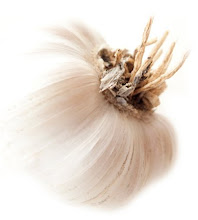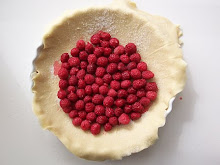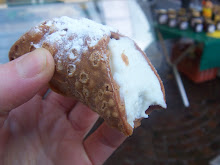
Sunday, 29 March 2009
Saturday, 21 March 2009
Cinque Terre
 One of the sites on my " to do'' list before ' tourist overflow and too hot' season begins was Cinque terre. Last Saturday was set as the official date for the day trip to the North west coast of Italy with weather forecast promising ideal conditions for a day at the seaside.
One of the sites on my " to do'' list before ' tourist overflow and too hot' season begins was Cinque terre. Last Saturday was set as the official date for the day trip to the North west coast of Italy with weather forecast promising ideal conditions for a day at the seaside.I jumped on the first bus to Parma, equipped myself with a Napolitanese pastry for the road and a quick cafe normale before boarding on the first train to the coast with fellow hungries Chris and Meghan, with whom I share, among other things, a common food obsession and thus anticipation.
A couple of hours later and we arrived at monterosso, the eastern village of the five along the Cinque terre path. The sun was shy, still hiding behind the clouds, but the turquoise sea and the terraced landscape were unabashed. We took a stroll around the village, before stopping at the local focaccia shop for a supply of focaccias (with a selection of local toppings) for the picnic break. Not before the hike. During. Damn.
Ready and able we began the hike to Vernazza, also known as 'the difficult one'. It clearly became evident to me that
a. I was not in shape at all
and
b. I had clearly been doing too much eating and too little exercising since I arrived in Italy.
It was tough and at one point it seemed as if going up will last forever, as every turn revealed what seemed like endless, uneven steps. As much as I hate the damn things, climbing each step brought the gradual revelation of the magnificent landscape; rows of vineyards, ripe lemon trees, cherry blossom , bright colored wild flowers and a sparkling blue Med. Overwhelming and indigestible, it was worth every muscle now aching in my body.
Skipping to Riomaggiore, to a lunch by the harbor eating a plate of locally fished small fried fish, Pesto Pasta and a plate of pretty little clams, accompanied by a chilled white wine.
Our final destination was the village of Manarola, just in time for the setting sun to bring out all the colors.
 The trail, the scenery, the sun, the sea, the climate, the company, the pesto, the lack of tourists, the perfect timing; everything was just right. My aching body and dozens of photographs are proof it all happened, or I could easily think none of it was real.
The trail, the scenery, the sun, the sea, the climate, the company, the pesto, the lack of tourists, the perfect timing; everything was just right. My aching body and dozens of photographs are proof it all happened, or I could easily think none of it was real. Who invented Disney World when this place exists??
Wednesday, 18 March 2009
Sunday, 15 March 2009
The Spanish Fiesta
 A week in Spain, I really can't complain.
A week in Spain, I really can't complain.This was a week that began on a bus to Milan Airport with an apple and oat muffin, and ended with 4 different types of cream filled Xuros (churros) and Porra on a bench, in the sun at the seaside town that is Vilanova I La Geltru, Catalonia, Spain.
In between there was mainly fried food; croquettes, fried calamari, fried artichokes, fried leeks, fried doughnuts are but a few, proving what is already a well known fact- deep fry anything and it tastes good.
I seemed to have misplaced my voice before leaving Italy. Spain was not to hear my voice, so whispering had to do. This, in turn, had inspired various games; a new category was invented in charades called Maladies charades, as well as the new lease of life to the forgotten game of Chinese whispers. Thus I was not the only one to whisper or communicate using a pen and paper.
Below is a list of some of the places we visited, food I ate and other paraphanelia.
 Barcelona
BarcelonaElche- great Paellas! I discovered a new favorite: Noodle paella with seafood and Alioli.
La Boqueria food market - yes its tourist central, and yes, the vendors are less than pleasant, but deep inside the technicolor market there is a fruit juice stand like no other; two young girls are touting 1 Euro plastic cups of freshly squeezed juices with fruit combinations such as coconut strawberry (my choice), cherry mango, Blackberry banana- it’s a bargain, its really pretty to look at and nutritious simultaneously!
Santa Caterina food market- Enrique Miralles designed the market renovation, yet another reason to fall in love with Barcelona and appreciate the work of a great architect. Located nearby to the gothic cathedral, the contemporary and the historical Barcelona feed off each other without outshining one another; this is what Barcelona does best.
An inspiring structure, its best feature, the roof, can only be seen by the surrounding apartments overlooking it.
Barcelona Reykjavik Bakery- run by a Catalan and Icelandic couple, this artisan bakery produces bread and pastry using ancient grain varieties and unrefined products. The bakery is located in the centre of town, surrounded by blooming almond trees.
Vila Vini Teca- a specialty food shop/ enoteca.
We had a tasting of a cheese from the Canary Islands among others. who knew.
Bubo- a patisserie designed to confuse you into thinking you have just entered a jewelry shop.
 Catalunia
CataluniaFundaciò Alícia- A foundation headed by Ferran Adrià, it is a centre focused on technological innovation in the science of food and nourishment. Set in a rural landscape, adjacent to a medieval monastery, this is another inspiring project bringing the old together with the new without causing a disturbance and proving that it can be done successful if done with enhanced sensitivity.
Located in Món Sant Benet, the Headquarters opened in 2007 and was designed by Clotet Paricio architects. The landscape, daylight and tranquility seep through the building creating a calm and relaxing environment.
We were given a tour of the facilities before a cooking demonstration of various dishes developed on- site for various restricted diets (celiac, protein allergies, phenylketonuria etc.).
Scala Dei- Up high on the southern slopes of the montsant range stands the first Carthusian monastery in the Iberian Peninsula, Santa Maria d'escaladei. The monks inhabited this area, planting crops and vines in particular, hence the origins of the Priorat wine producing region. We did not prepare ourselves to the cold climate, and even less so to the lack of heating. Naturally Carthusian monks were not interested in keeping warm; they wore sandals to feel closer to god. At the winery there was no heating, as one would expect. However, the tasting lunch at the adjacent hall was to be crispy, toasty warm. If only.
The cold cuts, solid olive oil, and wine were below serving temperature as were we. The landscape is sublime.
Capçanes- a cooperative of wine makers, this is the Catalan version of a kibutz! They even make a kosher wine.
Then there was a tough day. It began promising with a visit to the Pamies horticoles' greenhouse. A Slow Food activist, he is growing medicinal herbs and healing plants, amongst which is the stevia plant. This was not to be our last encounter.
This was followed by a welcome to a school of hotel management in Lleida; a good opportunity for the tutor to examine a few terrified students, giving random explanations about the entrance door and the library in the typical 'to your right you will find the door' manner.
The tour ended with organic cava, fried snails and souvenir bookmarks. By this point we were ready for lunch prepared especially for us using fresh produce from the herbal greenhouse. Surely one cant go wrong...
I won't go in detail to the tragic menu that began with a martini glass (?!?) filled with minced Stevia (this stuff tastes of aspartame and leaves an aftertaste you cant kill!) and ended with a dessert containing 'soil' according to the menu…
My taste buds were offended.
La Olivera winery- is located in La Vilella Alta.
The small village is set in a jaw- dropping- ly beautiful surrounding that challenges the Tuscan landscape. However, it is officially the coldest I can remember being. There seem to be few people that are willing to live in such a remote village under such climatic conditions, producing wine.
Nevertheless they produce interesting non traditional white wine varieties, as a result of the grapes grown under such a harsh climate and soil.
 Vilanova I La Geltru- is a typical small seaside town 40 km south West of Barcelona. This town is based mainly around fishing and tourism, accounting for all the fish and shopping we enjoyed.
Vilanova I La Geltru- is a typical small seaside town 40 km south West of Barcelona. This town is based mainly around fishing and tourism, accounting for all the fish and shopping we enjoyed.
The entire Mediterranean Sea life was on display in the food market as were the olive varieties.
This is also the place where I had tasted for the first time fresh peas from their pods. My entire life I had only ever eaten frozen/ cooked/mushy peas that taste nothing like the sweet and crunchy real thing. Never say never, but, Never again!
Monday, 9 March 2009
Hamantaschen
 Jewish Carnival time proposes a pastry baking opportunity I cannot miss, as any excuse will do. Roughly coinciding with the Christian carnival, this holiday is suspiciously similar, with the consumption of fried, sweet food, frivolous behavior and dressing up justified and encouraged.
Jewish Carnival time proposes a pastry baking opportunity I cannot miss, as any excuse will do. Roughly coinciding with the Christian carnival, this holiday is suspiciously similar, with the consumption of fried, sweet food, frivolous behavior and dressing up justified and encouraged.I'm just participating in the baking as one carnival a year is my quota so I made the traditional Hamantaschen, with a twist.
I know these are meant to be eaten once a year, but really there's no reason not to have them all year round. In essence, this is sweet pastry dough (pâte sablée ) filled, shaped and baked.
Regarding their shape- well, that’s tradition for you.
Hamantaschen
(Makes about 40)
For the dough
200g cold unsalted butter, diced into small cubes
2 cups of white flour
1/2 Tsp Baking powder
1/2 cup raw cane sugar
1Tsp vanilla extract
1/4 Tsp salt
Half the orange zest taken from one orange, chopped finely
75ml milk
For the filling
A handful of lightly roasted almonds, chopped
A handful of lightly roasted walnuts, chopped
A handful of raisins, chopped
1/2 roasted coconut flakes
A handful of crushed Amaretti cookies
2 pieces of candied ginger, chopped
1 Tsp Cinnamon
Remaining half of orange zest taken, chopped finely
1/4 cup milk
1/4 cup raw cane sugar
10g butter
To serve with
Icing sugar
Whether you're working with a food processor or by hand the key is to handle the dough as little as possible, or it will be hard once baked.
Mix the diced butter, flour, baking powder, sugar, vanilla extract, salt and orange zest until you get a coarse sand mixture. Add the milk and mix just until it forms a ball.
Form dough to a disc, wrap in plastic and refrigerate for 2 hours.
The filling
In a bowl mix the almonds, walnuts, raisins, coconut flakes, crushed Amaretti cookies, candied ginger, Cinnamon and orange zest.
Bring the milk, sugar and butter to a simmer.
Allow to cool slightly before adding to the dry mixture. you should have a moist, fragrant, chunky filling .
Heat the oven to 180°C.
Cut half of the dough in half. Replace one half in the fridge.
Roll the dough on a clean floured surface until it is about 3mm thick.
Using a cookie cutter or a glass, cut the dough into 10cm diameter circles.
Place a teaspoon of filling in the centre. Fold the dough by pinching it firmly in three points to form a triangular shape. Make sure the pastry covers the filling, leaving only a small window as the dough expands during baking revealing the filling.
Give the end points a little twist to ensure they stay closed during baking.
Bake in a tin lined with parchment paper until golden, about 15 minutes.
Repeat these guidelines for the remaining dough in the fridge.
Allow to cool.
Lightly dust with icing sugar.
(Makes about 40)
For the dough
200g cold unsalted butter, diced into small cubes
2 cups of white flour
1/2 Tsp Baking powder
1/2 cup raw cane sugar
1Tsp vanilla extract
1/4 Tsp salt
Half the orange zest taken from one orange, chopped finely
75ml milk
For the filling
A handful of lightly roasted almonds, chopped
A handful of lightly roasted walnuts, chopped
A handful of raisins, chopped
1/2 roasted coconut flakes
A handful of crushed Amaretti cookies
2 pieces of candied ginger, chopped
1 Tsp Cinnamon
Remaining half of orange zest taken, chopped finely
1/4 cup milk
1/4 cup raw cane sugar
10g butter
To serve with
Icing sugar
Whether you're working with a food processor or by hand the key is to handle the dough as little as possible, or it will be hard once baked.
Mix the diced butter, flour, baking powder, sugar, vanilla extract, salt and orange zest until you get a coarse sand mixture. Add the milk and mix just until it forms a ball.
Form dough to a disc, wrap in plastic and refrigerate for 2 hours.
The filling
In a bowl mix the almonds, walnuts, raisins, coconut flakes, crushed Amaretti cookies, candied ginger, Cinnamon and orange zest.
Bring the milk, sugar and butter to a simmer.
Allow to cool slightly before adding to the dry mixture. you should have a moist, fragrant, chunky filling .
Heat the oven to 180°C.
Cut half of the dough in half. Replace one half in the fridge.
Roll the dough on a clean floured surface until it is about 3mm thick.
Using a cookie cutter or a glass, cut the dough into 10cm diameter circles.
Place a teaspoon of filling in the centre. Fold the dough by pinching it firmly in three points to form a triangular shape. Make sure the pastry covers the filling, leaving only a small window as the dough expands during baking revealing the filling.
Give the end points a little twist to ensure they stay closed during baking.
Bake in a tin lined with parchment paper until golden, about 15 minutes.
Repeat these guidelines for the remaining dough in the fridge.
Allow to cool.
Lightly dust with icing sugar.
Keep in an airtight container.
Variation:
Feel free to experiment with the shape as well as the filling options.
The recipe proved versatile; I crushed a batch to make streusel sprinkled on top of a chopped granny smith apple for a quick apple crumble. this made my palette very happy.
Saturday, 7 March 2009
Cured meat
 23 of anything can't be a good thing.
23 of anything can't be a good thing.Following the chocolate tasting session that consisted of 23 different pieces of chocolate it was time for cured meat tasting, 23 different types to be exact (+ a bonus cut...).
Once again the tasting took place after a ususally large lunch, and featured cured ham, cooked ham, smoked ham and pork by-products such as the ominpresent yet not always announced lard varieties, and mortadella cuts (that make use of tripe, skin emulsion, and other appetizing bits and pieces).
Lest we forget novelty cuts such as cured sheep leg (bearing an uncanny resemblance to the sole of my shoe), and the petite cured goose leg.
Oh, and there was Cava too, to wash it all down.
It's at times like this I remind myself how pleasant it is to live in a bubble…
Till the next tasting…
Subscribe to:
Comments (Atom)









